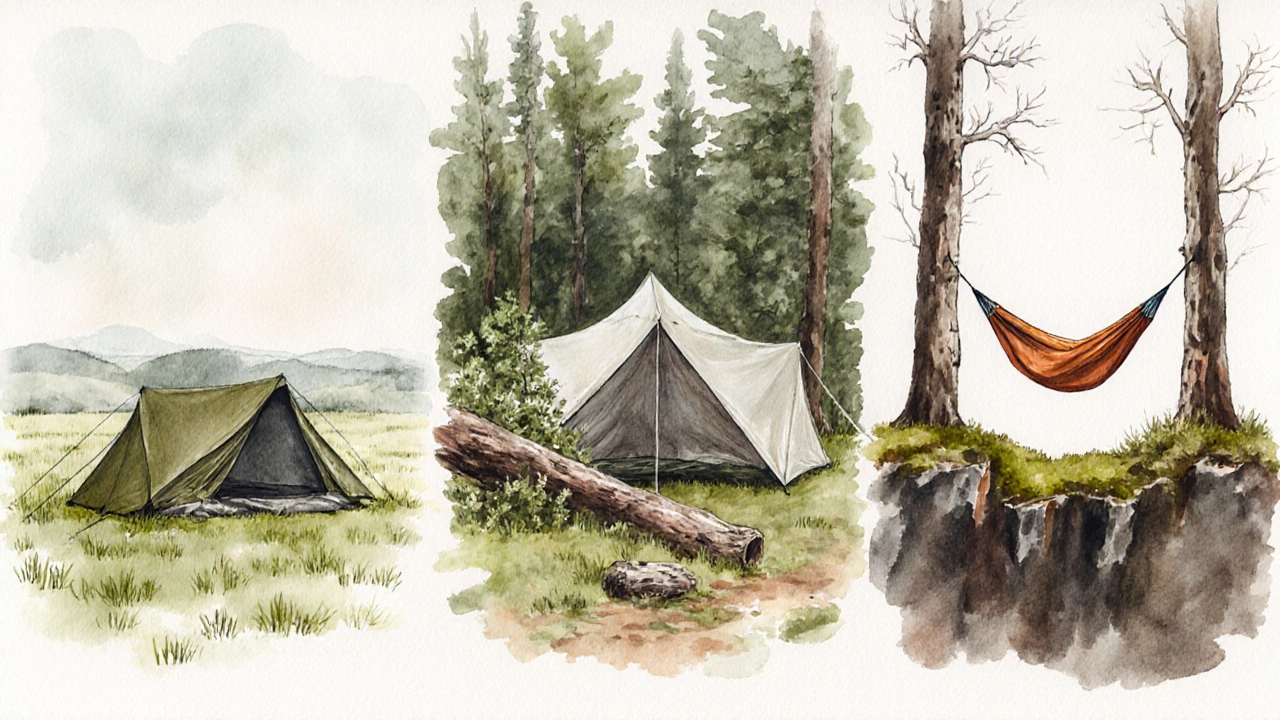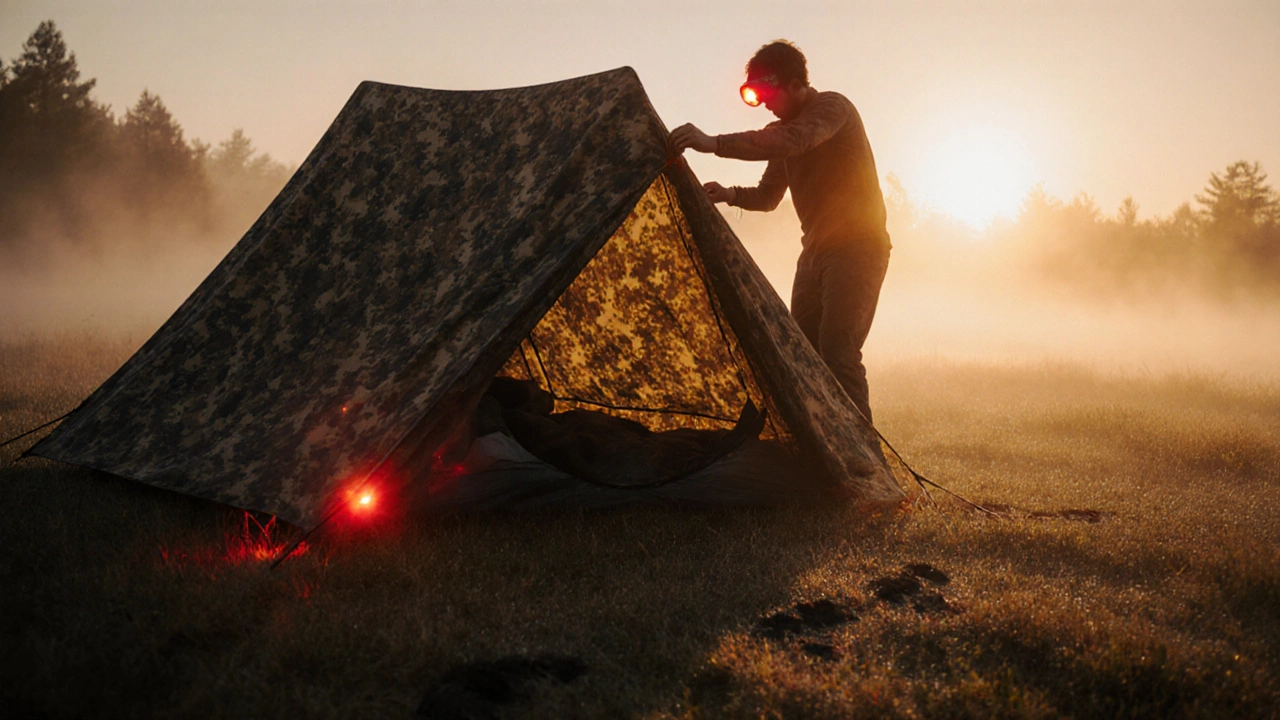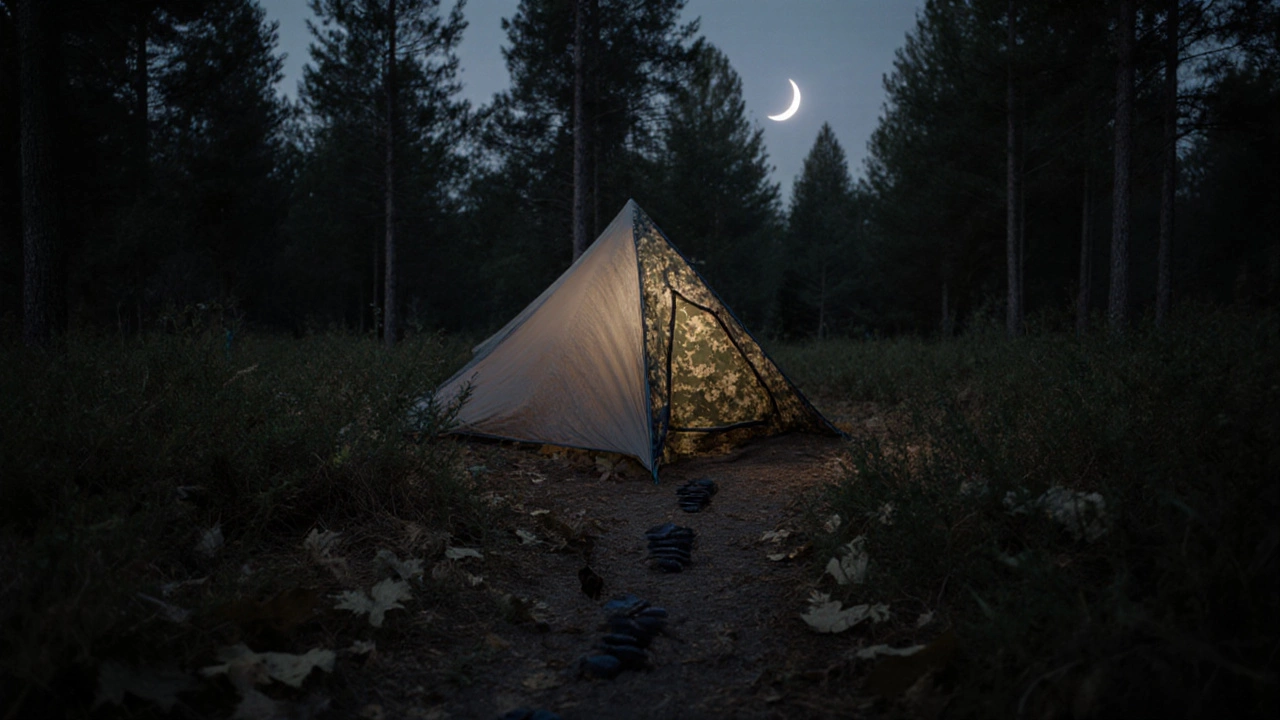Stealth Camping Gear Selector
Select Your Preferences
Choose your camping conditions to get personalized gear recommendations.
Recommended Gear
Gear Comparison Table
| Gear | Visibility | Weight (g) | Weather Protection | Ideal Terrain |
|---|---|---|---|---|
| Low-profile tent | Low | 1200-1500 | Excellent (rainfly, insulation) | Open meadows, flat ground |
| Tarp shelter | Very Low | 400-600 | Good (depends on tarp shape) | Forests, rocky slopes |
| Hammock | Medium-Low | 800-1000 | Moderate (add rainfly) | Tree-dense areas |
Stealth camping is a style of camping that aims to stay hidden and leave no trace on public or private lands. It’s not about breaking the law; it’s about merging into the landscape so you barely register as a visitor.
Key Takeaways
- Stealth camping means low‑profile gear, minimal impact, and respecting land rules.
- Legalities vary by country, region, and land type; always check local regulations.
- Essential gear includes a low‑profile tent or tarp, a compact sleeping system, and navigation tools.
- Safety hinges on discreet fire handling, wildlife awareness, and a solid exit plan.
- Use the checklist at the end to run through every prep step.
stealth camping lets you explore remote spots without the crowds, while keeping nature pristine.
What Exactly Is Stealth Camping?
At its core, stealth camping is a low‑impact, low‑visibility camping practice that blends into the surroundings. Campers use camouflaged gear, set up after dusk, and break down before sunrise, leaving nothing but footprints that quickly fade.
Why Choose a Low‑Profile Approach?
Most campers love popular campsites, but they can get noisy, crowded, and regulated. Stealth camping offers:
- Freedom to camp in untouched wilderness.
- Enhanced connection with nature without other people nearby.
- Cost savings-no fees for campsite reservations.
- A chance to practice Leave No Trace principles that minimize human impact on the environment.

Legal & Ethical Considerations
Before you set up, know the rules:
- Public land areas owned by government agencies such as national forests or state parks often allow dispersed camping, but each agency sets its own time limits (usually 14‑day stays).
- National parks generally prohibit camping outside designated sites. Ignoring this can lead to fines.
- Private property requires explicit permission from the landowner. A quick text or note can save you a legal headache.
- Always respect local wildlife and cultural sites; disturbance can have lasting ecological effects.
Gear for a Low‑Profile Stay
The right equipment makes staying hidden easy. Below is a quick comparison of the three most popular setups.
| Gear | Visibility | Weight (g) | Weather Protection | Ideal Terrain |
|---|---|---|---|---|
| Low‑profile tent | Low | 1200‑1500 | Excellent (rainfly, insulation) | Open meadows, flat ground |
| Tarp shelter | Very low | 400‑600 | Good (depends on tarp shape) | Forests, rocky slopes |
| Hammock | Medium‑low | 800‑1000 | Moderate (add rainfly) | Tree‑dense areas |
Most stealth campers favor a tarp because it packs small, blends with the ground, and can be set up in seconds. Pair it with a bivy sack and a compact sleeping bag rated for 0‑5°C for all‑season comfort.
Finding the Right Spot
Scouting is half the adventure. Follow these steps:
- Use a GPS device or smartphone app with offline maps to locate forest edges, clearings, or water sources.
- Look for natural windbreaks-boulders, fallen logs, or dense shrubbery-to hide your silhouette.
- Check for signs of recent human activity. Fresh tire tracks or fire rings suggest the area is already frequented and may be less risky.
- Stay at least 200‑300 meters from roads, trailheads, and visible viewpoints.
- Test the ground for flatness and drainage; a slight slope helps water run off your tarp.

Safety Tips & Nighttime Practices
Even though you’re aiming to be unseen, safety can’t be invisible.
- Carry a compact headlamp with a red light mode to preserve night vision. Keep it low‑beam and point down.
- Never build a smoky fire. A small alcohol stove or a contained campstove leaves no trace and reduces fire risk.
- Store food in airtight containers and hang it at least 3 meters high to keep curious critters away.
- Tell a friend your planned location and expected return time. A simple text check‑in can be a lifesaver.
- Know the local wildlife. In New Zealand, for example, keep an eye out for possums and rodents; in North America, bear safety is crucial.
Stealth Camping Checklist
- Research land use rules (public vs private, national park restrictions).
- Pack low‑profile gear: tarp or ultralight tent, bivy sack, compact sleeping bag.
- Bring navigation tools: GPS, paper map, compass.
- Pack a headlamp, small stove, and a micro‑metal water filter.
- Prepare a Leave No Trace kit: trash bags, trowel, biodegradable soap.
- Set up after dusk and break down before sunrise.
- Check weather forecast; be ready to relocate if conditions worsen.
Frequently Asked Questions
Is stealth camping legal?
Legality depends on the land type. Public lands often allow dispersed camping with limits, while national parks usually require designated sites. Private property always needs owner permission.
What’s the best gear for staying hidden?
A lightweight tarp with a bivy sack offers the smallest silhouette and packs tiny. Pair it with a low‑profile sleeping pad and a compact, earth‑tone sleeping bag.
How far should I camp from a trail?
Aim for at least 200‑300 meters (650‑1000 feet). That distance reduces the chance of being spotted and protects the trail from trampling.
Can I use a portable toilet while stealth camping?
Yes-dig a cathole at least 60 cm deep and 20 meters away from water sources. Pack out solid waste if you’re on stricter lands.
What’s the biggest mistake beginners make?
Arriving without checking local regulations. You could unintentionally trespass, face fines, or damage the environment.
